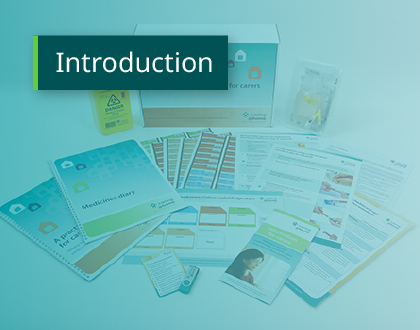Published: 28 September 2018
Transcript
[Music plays]
[Text on screen] caring@home
>>Narrator (female voice over): If you're watching these videos, it means you're part of a team caring for someone at home. Together with your healthcare professionals, you're helping to keep this person as comfortable as possible in their own home. The caring@home package for carers has been specifically designed to provide you with practical information and skills to help manage breakthrough symptoms safely using subcutaneous medicines. The most important part of the package is the one on one training session with a nurse.
[Text on screen] Breakthrough symptoms
>>Narrator (female voice over): Even when people are taking regular medicine to manage a symptom, sometimes the symptom can unexpectedly get worse and become distressing. When this occurs, it is called a breakthrough symptom and it may require an extra dose of medicine to make sure that the person remains as comfortable as possible.
Often towards the end of someone's life, it may not be suitable to give them an extra dose of medicine using tablets. In this case, one way to give medicine is under the skin or what is called subcutaneously. This is a safe and effective way to give medicine. You can be taught to give subcutaneous medicine to the person you are caring for.
This means that the person can get symptom relief quickly without having to wait for a nurse or doctor to visit at home.
[Text on screen] Recognise and rate breakthrough symptoms
>>Narrator (female voice over): Your nurse will teach you how to recognise and rate breakthrough symptoms.
[Text on screen] Select the correct medicine prescribed for a particular symptom
>>Narrator (female voice over): Select the correct medicine prescribed for a particular symptom.
[Text on screen] Prepare and give subcutaneous medicine and record this in a medicines diary
>>Narrator (female voice over): Prepare and give subcutaneous medicine and record this in a medicines diary.
[Text on screen] Check the subcutaneous cannula
>>Narrator (female voice over): Check the subcutaneous cannula.
[Text on screen] Safely store medicines and dispose of all unused medicines
>>Narrator (female voice over): Safely store medicines and dispose of all unused medicines.
[Text on screen] During this one on one teaching session, your nurse will give you plenty of time to ask questions
>>Narrator (female voice over): During this one on one teaching session, your nurse will give you plenty of time to ask questions. The most important thing for you to know as a carer is that you are part of a team and you are not alone. The decision to help is voluntary and yours to make. Your healthcare team will not pressure you to accept this task.
If you are unable to do it, simply tell your healthcare team. Please remember that if you are unsure, concerned or want further explanation, you can talk further with your doctor or nurse.
[Text on screen] caring@home
[Music ends]
End of transcript

- Audience General public
- FormatVideo
- LanguageEnglish
- Last updated04 December 2024
Details
This resource is part of our standard caring@home resources package.
